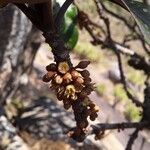A large tree up to 17 m high when growing in forests but, in its more characteristic form, a shrub, already flowering and fruiting freely when only about 1 m high; innovations and twigs rusty-tomentose. Leaves coriaceous, at first with a white bloom but soon glabrous and green above, rufo-or aureo-tomentose below, becoming greyish or silvery-tomentose, 4-15 cm, sometimes up to 30 cm long, 2-5 cm, sometimes up to 7 cm wide, oblanceolate-cuneate, oblong-obovate, obovate-elliptic or oblong, usually rounded or slightly narrowed, rarely cuneate at the base, emarginate, retuse or obtuse at the apex, sometimes mucronate; midrib impressed above, very prominent below; secondary nerves numerous, slender, usually inconspicuous above, often becoming slightly prominent beneath, patent, at first straight, ascending and curved towards the margin; petioles 6-12 mm, rarely up to 24 mm long; stipules long-subulate, often curved, pubescent, early deciduous. Flowers in few-to many-flowered, sometimes very dense, fascicles, the majority usually on the lower leafless parts of the branches or on older wood on sometimes rather large, raised warts, and fewer, or none, in the leaf axils; bracts 0 or very minute; pedicels densely rufo-tomentose, 2-10 mm long or, rarely, flowers sessile. Calyx 2.5-5 mm long, rusty-tomentose outside; sepals free nearly to the base, often unequal, ovate, obtuse or subacute. Corolla white or whitish, turning reddish or brown, glabrous, up to 2 mm longer than the calyx; tube cylindric-urceolate, 0.5-2 mm, usually 1-1.5 mm long, the lobes spreading, broadly ovate, obtuse or subacute, 2-4.5 mm long and about 2 mm wide. Alternipetalous staminodes 0 or sometimes 1-5, inserted just below the sinuses between the corolla-1obes, much smaller than the latter, scale-like and minute or sometimes petaloid, ovate or suborbicular, more or less irregularly serrate, dentate or incised in the upper half, up to 1.5 mm long and 0.5-1 mm wide. Stamens inserted at the base of the corolla-1obes; filaments 1.5-2 mm long; anthers 1-2 mm long, apiculate; sometimes stamens sterile, staminodial, either resembling a stamen with a filament-like basal portion and a sagittate-cordate broader top, or more irregularly shaped, very rarely lanceolate, petaloid. Ovary globose-ovoid, about 2 mm in diam., densely villous; style glabrous, about 1.5 mm long. Fruit ellipsoid, about 2.5 cm long and 1.8 cm in diam., dark dull-red when ripe, edible, crowned with the persistent style, 1-or sometimes 2-seeded. Seeds of 1-seeded fruits compressed-ovoid, 1.6-2 cm long, 1.4-1.6 cm broad and 0.8-1.1 cm thick; those of 2-seeded fruits with one flattened lateral side; testa light brown, shiny, thin and brittle when dry; scar linear-triangular, ventral, occupying about 3/4 of the length of the seed, 2 mm wide or more in widest place.
More
A shrub or small tree. It can grow to 15 m tall. It can occasionally grow up to 33 m. Often the roots are twisted around a rock. It has a leafy rounded crown. The trunk is thin and has flutes along it. The stem is mostly short and thick and the branches can touch the ground. Often the trunk has wart like growths. The bark is grey and rough. The leaves are simple and alternate. They are often crowded towards the ends of branches. The leaves are firm and leathery. The leaves are oval and dark green and shiny on top but brown and hairy underneath. The young shoots and twigs have dense rusty hairs. The upper leaf surface often has a bloom. The under surface of the leaves has silver or red hairs. The leaves are 5-10 cm long but can be 30 cm long. The leaf stalks are 0.6-2.5 cm long. Flowers are fruit are produced on old wood. The flowers buds occur in clusters often on knobs on the branches and trunk. The fruit are 2.5 cm long. They are bright red when ripe. There is a small point at the end. The fruit have a leathery skin and 2 stones inside. The flesh is purple and they have a sticky latex. The seeds are oval and 1.7 x 1.4 cm.
Large tree or shrub, 1 m or up to 17 m high. Leaves usually rounded or emarginate at apex, usually rusty-tomentose on lower surface. Flowers usually pedicellate, fasciculate or solitary, often on raised warts on naked branches below leaves; white or whitish turning reddish or brown.


